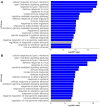This is a preprint.
A multi-trait epigenome-wide association study identified DNA methylation signature of inflammation among people with HIV
- PMID: 38854093
- PMCID: PMC11160930
- DOI: 10.21203/rs.3.rs-4419840/v1
A multi-trait epigenome-wide association study identified DNA methylation signature of inflammation among people with HIV
Update in
-
A multi-trait epigenome-wide association study identified DNA methylation signature of inflammation among men with HIV.Clin Epigenetics. 2024 Nov 2;16(1):152. doi: 10.1186/s13148-024-01763-2. Clin Epigenetics. 2024. PMID: 39488703 Free PMC article.
Abstract
Inflammation underlies many conditions causing excess morbidity and mortality among people with HIV (PWH). A handful of single-trait epigenome-wide association studies (EWAS) have suggested that inflammation is associated with DNA methylation (DNAm) among PWH. Multi-trait EWAS may further improve statistical power and reveal pathways in common between different inflammatory markers. We conducted single-trait EWAS of three inflammatory markers (soluble CD14, D-dimers, and interleukin 6) in the Veteran Aging Cohort Study (n = 920). The study population was all male PWH with an average age of 51 years, and 82.3% self-reported as Black. We then applied two multi-trait EWAS methods-CPASSOC and OmniTest-to combine single-trait EWAS results. CPASSOC and OmniTest identified 189 and 157 inflammation-associated DNAm sites respectively, of which 112 overlapped. Among the identified sites, 56% were not significant in any single-trait EWAS. Top sites were mapped to inflammation-related genes including IFITM1, PARP9 and STAT1. These genes were significantly enriched in pathways such as "type I interferon signaling" and "immune response to virus". We demonstrate that multi-trait EWAS can improve the discovery of inflammation-associated DNAm sites, genes, and pathways. These DNAm sites suggest molecular mechanisms in response to inflammation associated with HIV and might hold the key to addressing persistent inflammation in PWH.
Keywords: D-dimer; EWAS; HIV; IL-6; sCD14.
Conflict of interest statement
V.C.M. has received investigator-initiated research grants (to the institution) and consultation fees from Eli Lilly, Bayer, Gilead Sciences, Merck, and ViiV. V.C.M. has received funding support from NIH/NIDDK (R01DK125187) and the Emory Center for AIDS Research (P30AI050409) for work related to this manuscript.
Figures





Similar articles
-
A multi-trait epigenome-wide association study identified DNA methylation signature of inflammation among men with HIV.Clin Epigenetics. 2024 Nov 2;16(1):152. doi: 10.1186/s13148-024-01763-2. Clin Epigenetics. 2024. PMID: 39488703 Free PMC article.
-
Soluble CD14-associated DNA methylation sites predict mortality among men with HIV infection.AIDS. 2022 Sep 1;36(11):1563-1571. doi: 10.1097/QAD.0000000000003279. Epub 2022 Jun 21. AIDS. 2022. PMID: 35979830 Free PMC article.
-
Epigenome-Wide and Methylation Risk Score Analysis of Body Mass Index Among People with HIV.Epigenomes. 2024 Dec 12;8(4):46. doi: 10.3390/epigenomes8040046. Epigenomes. 2024. PMID: 39727808 Free PMC article.
-
Epigenome-wide association study on ambient PM2.5 exposure in Han Chinese, the NSPT study.Environ Res. 2024 Apr 15;247:118276. doi: 10.1016/j.envres.2024.118276. Epub 2024 Jan 19. Environ Res. 2024. PMID: 38246299
-
Epigenetics and Inflammatory Markers: A Systematic Review of the Current Evidence.Int J Inflam. 2019 May 8;2019:6273680. doi: 10.1155/2019/6273680. eCollection 2019. Int J Inflam. 2019. PMID: 31205673 Free PMC article. Review.
References
-
- So-Armah KA, Tate JP, Chang CH, et al. Do Biomarkers of Inflammation, Monocyte Activation, and Altered Coagulation Explain Excess Mortality Between HIV Infected and Uninfected People? Journal of acquired immune deficiency syndromes (1999). Jun 1 2016;72(2):206–213. doi:10.1097/qai.0000000000000954 - DOI - PMC - PubMed
Publication types
Grants and funding
LinkOut - more resources
Full Text Sources
Research Materials
Miscellaneous

